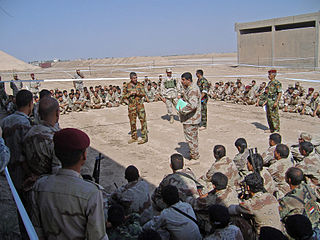
The 101st Airborne Division (Air Assault) ("Screaming Eagles") is a light infantry division of the United States Army that specializes in air assault operations. It can plan, coordinate, and execute multiple battalion-size air assault operations to seize terrain. These operations can be conducted by mobile teams covering large distances, fighting behind enemy lines, and working in austere environments with limited or degraded infrastructure. It was active in, for example, foreign internal defense and counterterrorism operations in Iraq, in Afghanistan in 2015–2016, and in Syria, as part of Operation Inherent Resolve in 2018–2021.

After the handover of sovereignty, Operation Squeeze Play was a combined U.S./Iraqi sweep of the western suburbs of Baghdad launched on 22 May 2005. Almost 300 suspects were detained in the first day of the operation.
Soldiers from the U.S. 1st Armored Division's 3rd Brigade Combat Team struck at insurgent elements in the Al Mansor district on the west side of Baghdad on 7 December 2003, according to U.S. Central Command officials.

The 4th Brigade, 2nd Infantry Division ("Raiders") is an inactive Stryker Brigade Combat Team (SBCT) of the United States Army. The brigade was activated at Fort Lewis, Washington on 1 June 2006 by reflagging the 2nd Stryker Cavalry Regiment. The 4th Stryker Brigade had the distinction of being the last U.S. Army combat brigade to serve in support of Operation Iraqi Freedom. The brigade deployed three times in support of the War on Terror, to Iraq from 2007–2008 and from 2009–2010, and to Afghanistan from 2012–2013 before inactivating in March 2014.

The Battle of Ramadi was fought during the Iraq War from March 2006 to November 2006, for control of the capital of the Al Anbar Governorate in western Iraq. A joint US military force under the command 1st Brigade Combat Team, 1st Armored Division and Iraqi Security Forces fought insurgents for control of key locations in Ramadi. Coalition strategy relied on establishing a number of patrol bases called Combat Operation Posts throughout the city.
Operation River Falcon was a military operation in the Iraq War. From 25 to 27 July 2006, elements of the United States Army 2nd Brigade Combat Team, 4th Infantry Division conducted Operation River Falcon in and around the town of Sayifiyeh in Iraq. The operation was aimed at denying terrorists the use of the town as a safe haven, disrupting insurgent attacks on Coalition and Iraqi Army/Police, and on collecting and destroying insurgent munitions.
Operation Able Rising Force was a military operation in December 2005 in Iraq by US troops and Iraqi police and troops for purposes of counterinsurgency to locate and detain suspected terrorists.
Operation Ardennes was part of the Iraq War.

The Battle of Baqubah II took place during the Iraq War in the capital of the Iraqi province Diyala, to the north-east of Baghdad. It began in early March 2007, when U.S. and Iraqi forces commenced preliminary operations to "establish a presence in Diyala beyond their Forward Operating Base".

Operation Phantom Thunder began on 16 June 2007, when Multi-National Force-Iraq launched major offensive operations against al-Qaeda and other extremist terrorists operating throughout Iraq. It was the largest coordinated military operation since the 2003 invasion of Iraq. Operation Phantom Thunder was a corps level operation, including Operation Arrowhead Ripper in Diyala Province, Operation Marne Torch and Operation Commando Eagle in Babil Province, Operation Fardh al-Qanoon in Baghdad, Operation Alljah in Anbar Province, and continuing special forces actions against the Mahdi Army in southern Iraq and against Al-Qaeda leadership throughout the country. The operation was one of the biggest military operations in Iraq since the U.S. invasion in 2003.

Operation Commando Eagle was a 2007 military operation of the Iraq War. It began on 21 June 2007, when Iraqi and Coalition forces launched a combined ground and air assault operation against al-Qaeda and other extremist terrorists operating in the Mahmudiyah region of Babil province. The action was intended to curb terrorist activity southwest of Baghdad through a mix of helicopter assaults and Humvee-mounted movements.
Operation Saber Guardian was a joint operation between 3rd Battalion, 3rd Brigade, 5th Iraqi Army soldiers, local concerned citizens, and 6-9 Armored Reconnaissance Squadron, 3rd Brigade Combat Team, 1st Cavalry Division. The operation, targeted at al-Qaida leadership near the town of Sherween, Iraq, resulted in 20 al-Qaida terrorists killed, 20 detained, and two weapons caches and 12 improvised explosive devices discovered.

Operation Phantom Strike was a major offensive launched by the Multi-National Corps – Iraq on 15 August 2007 in a crackdown to disrupt both the al-Qaeda-affiliated Islamic State of Iraq and Shia insurgent operations in Iraq. It consisted of a number of simultaneous operations throughout Iraq focused on pursuing remaining ISI terrorists and Iranian-supported insurgent groups. It was concluded in January 2008 and followed up with Operation Phantom Phoenix.
Operation Phantom Phoenix was a major nationwide offensive launched by the Multinational Force Iraq (MNF-I) on 8 January 2008 in an attempt to build on the success of the two previous corps-level operations, Operation Phantom Thunder and Operation Phantom Strike and further reduce violence and secure Iraq's population, particularly in the capital Baghdad. The offensive consisted of a number of joint Coalition and Iraqi Army operations throughout northern Iraq as well as in the southern Baghdad Belts.
The 2008 Nineveh campaign was a series of offensives and counter-attacks between insurgent and Coalition forces for control of the Nineveh Governorate in northern Iraq in early-to-mid-2008. Some fighting also occurred in the neighboring Kirkuk Governorate.

The Army of the Men of the Naqshbandi Order, also called the Naqshbandi Army, is one of a number of underground Ba'athist and Sufi militant insurgency groups fighting U.S.-led Coalition forces in Iraq. Media frequently refers to the group by the initials JRTN, a romanization of its Arabic name. Supreme Command for Jihad and Liberation, technically the name of the umbrella organisation to which JRTN belongs, is also often used to refer to JRTN specifically.

Operation Sayeed also known as Operation Hunter in English, was a series of operations conducted in western Al Anbar Governorate by the United States Marine Corps in 2005. It was an umbrella operation, consisting of at least 11 named operations between July 2005 to December 2005. The purpose was to drive Al-Qaeda in Iraq forces from the Western Euphrates River Valley. Some parts of Operation Sayeed were Operation Steel Curtain and Operation Iron Fist.
The 101st Airborne Division is a specialized modular light infantry division of the US Army trained for air assault operations. The Screaming Eagles has been referred to by journalists as "the tip of the spear" as well as one of the most potent and tactically mobile of the U.S. Army's divisions. The 101st Airborne Division has a history that is nearly a century long. During World War II, it was renowned for its role in Operation Overlord, Operation Market Garden, the liberation of the Netherlands and its action during the Battle of the Bulge around the city of Bastogne, Belgium. During the Vietnam War, the 101st Airborne Division fought in several major campaigns and battles, including the Battle of Hamburger Hill in May 1969. In mid-1968, it was reorganized and redesignated as an airmobile division and then in 1974 as an air assault division. In recent years, the division has served in Iraq and Afghanistan. At the height of the War on Terror, the 101st Airborne Division had over 200 aircraft. The division now has slightly over 100 aircraft.
This is a timeline of events during the Islamic State insurgency in Iraq (2017–present) in 2021.
This is a timeline of events during the Islamic State insurgency in Iraq (2017–present) in 2019.








